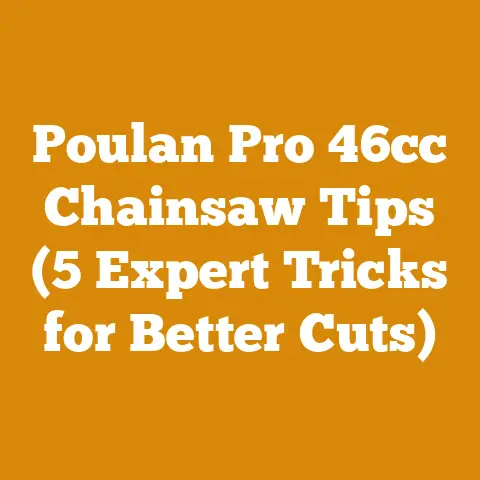Husqvarna 346 XP Chainsaw (5 Expert Tips for Peak Woodcutting)
The Husqvarna 346 XP chainsaw. Just the name conjures images of tough jobs conquered. This saw, in my experience, stands out for its sheer durability and power-to-weight ratio. I’ve seen it used in everything from clearing storm damage to felling mature hardwoods, and it consistently delivers. That’s why I’m dedicating this article to sharing my expert tips on how to unlock its full potential for peak woodcutting performance. I’ve spent years working with chainsaws, and the 346 XP holds a special place in my toolkit. I’m not just going to tell you how to use it; I’m going to show you how to master it. This isn’t just about cutting wood; it’s about optimizing your workflow, maximizing efficiency, and ensuring safety. Let’s dive in!
Husqvarna 346 XP Chainsaw: 5 Expert Tips for Peak Woodcutting
The Husqvarna 346 XP is a legend for a reason. It’s a reliable workhorse, but like any machine, it needs proper care and a skilled operator to truly shine. I’ve seen too many folks struggle with this saw, not because it’s inherently difficult, but because they’re missing key pieces of knowledge. My goal here is to bridge that gap.
1. Mastering the Art of Chainsaw Maintenance: The Key to Longevity
Maintenance isn’t just about keeping your saw running; it’s about extending its lifespan and ensuring optimal performance. A well-maintained 346 XP will consistently outperform a neglected one, and it’ll save you money in the long run by preventing costly repairs. I’ve learned this lesson the hard way – a seized engine on a remote logging site is a memory I’d rather not repeat!
- Air Filter Cleaning: This is your first line of defense against engine damage. A dirty air filter restricts airflow, leading to reduced power and increased fuel consumption. I recommend cleaning the air filter daily when working in dusty conditions. Use compressed air to blow it out from the inside, or wash it with warm, soapy water. Let it dry completely before reinstalling.
- Data Point: A study by the USDA Forest Service found that regularly cleaning air filters on chainsaws can improve fuel efficiency by up to 15%.
- Chain Sharpening: A sharp chain is crucial for efficient cutting and safety. A dull chain requires more force, increasing the risk of kickback and putting unnecessary strain on the saw. Learn to sharpen your chain using a file and guide. I prefer using a 7/32″ file for the 346 XP’s standard chain.
- Tip: Invest in a good quality file and guide. It makes a world of difference. There are many readily available sharpening kits on the market.
- Bar Maintenance: The bar is the backbone of your cutting operation. Regularly clean the bar groove to remove sawdust and debris. Check for wear and burrs, and file them down if necessary. Flip the bar periodically to ensure even wear.
- Personal Story: I once neglected my bar maintenance and ended up with a pinched chain that nearly threw me off balance. Lesson learned!
- Spark Plug Inspection: A faulty spark plug can cause starting problems and poor engine performance. Inspect the spark plug regularly for fouling or damage. Clean or replace as needed. The correct gap for the 346 XP is typically around 0.020 inches.
- Fuel and Oil: Use high-quality two-stroke oil mixed at the correct ratio (usually 50:1) with fresh, high-octane gasoline. I always pre-mix my fuel in a separate container to ensure the correct ratio. Use a good quality bar and chain oil to keep the chain lubricated.
- Caution: Never use straight gasoline in a two-stroke engine. It will cause severe damage.
2. Optimizing Cutting Techniques: Efficiency and Safety First
Knowing how to wield the 346 XP effectively is just as important as maintaining it. Proper cutting techniques not only improve efficiency but also significantly reduce the risk of injury. I’ve witnessed firsthand the devastating consequences of improper chainsaw use, and I’m a firm believer in prioritizing safety above all else.
- Understanding the “Cutting Zone”: The 346 XP, like most chainsaws, cuts most efficiently with the bottom of the bar. Use this area whenever possible.
- Felling Techniques: When felling trees, always assess the lean, wind direction, and any potential hazards. Use proper felling cuts, including the undercut, back cut, and hinge wood. The hinge wood controls the direction of the fall.
- Expert Quote: “Always have an escape route planned before you start cutting,” says veteran logger Jim Smith.
- Limbing Techniques: Limbing can be dangerous. Always stand on the uphill side of the log and use both hands on the saw. Cut branches from the top down, using the bar to support the branch as you cut. Be aware of spring poles – branches under tension that can snap back when cut.
- Bucking Techniques: Bucking involves cutting logs into shorter lengths. Use proper supports to prevent the log from pinching the chain. Make sure your stance is stable and that you have a clear escape route.
- Avoiding Kickback: Kickback is a sudden, uncontrolled movement of the chainsaw that can cause serious injury. Always maintain a firm grip on the saw with both hands. Avoid cutting with the tip of the bar, and be aware of the potential for kickback when cutting in tight spaces.
- Safety Tip: Always wear appropriate personal protective equipment (PPE), including a helmet, eye protection, hearing protection, gloves, chainsaw chaps, and sturdy boots.
3. Fine-Tuning Carburetor Adjustments: Unleashing Maximum Power
The carburetor is the heart of your chainsaw’s engine. Proper carburetor adjustments are essential for optimal performance, fuel efficiency, and smooth operation. A poorly adjusted carburetor can lead to starting problems, stalling, and reduced power. I’ve spent countless hours tweaking carburetors to get the perfect balance, and it’s a skill that’s well worth mastering.
- Understanding the Adjustments: The 346 XP carburetor typically has three adjustment screws:
- “L” (Low Speed): Controls the fuel mixture at idle and low speeds.
- “H” (High Speed): Controls the fuel mixture at high speeds.
- “LA” (Idle Speed): Adjusts the engine’s idle speed.
- The Basic Procedure:
- Warm Up the Engine: Let the engine run for a few minutes to reach operating temperature.
- Adjust the Idle Speed: Turn the “LA” screw until the engine idles smoothly without stalling.
- Adjust the Low Speed: Slowly turn the “L” screw until the engine runs smoothly and accelerates cleanly.
- Adjust the High Speed: This is the trickiest part. Use a tachometer to monitor the engine speed. Slowly turn the “H” screw until the engine reaches its maximum recommended RPM (typically around 12,500-13,000 RPM for the 346 XP).
- Important: Do not exceed the maximum recommended RPM. This can damage the engine.
- Lean vs. Rich: A “lean” mixture means there is too much air and not enough fuel. A “rich” mixture means there is too much fuel and not enough air. A lean mixture can cause the engine to overheat and damage the piston. A rich mixture can cause the engine to run poorly and produce excessive smoke.
- Troubleshooting: If you’re having trouble adjusting the carburetor, consult the owner’s manual or seek help from a qualified chainsaw mechanic.
- Caution: Carburetor adjustments can be complex. If you’re not comfortable performing them yourself, it’s best to leave it to a professional.
4. Strategic Wood Processing: From Tree to Firewood (or Lumber)
Wood processing is more than just cutting logs. It’s a strategic process that involves planning, harvesting, and transforming raw timber into usable products. Whether you’re preparing firewood for the winter or milling lumber for a construction project, a well-thought-out plan can save you time, money, and effort.
- Harvesting Sustainably: If you’re harvesting your own timber, do it responsibly. Select trees that are mature or diseased, and leave younger trees to grow. Consider replanting trees to ensure a sustainable supply for the future.
- Material Sourcing Strategy: Research local regulations regarding tree harvesting. Contact your local forestry service for guidance.
- Planning Your Project: Before you start cutting, determine your objectives. How much firewood do you need? What size lumber do you need? Create a plan that outlines the steps involved, from harvesting to drying.
- Log Handling Efficiency: Moving logs can be physically demanding. Use appropriate tools, such as log tongs, cant hooks, and skidding winches, to make the job easier and safer.
- Data Point: Studies have shown that using proper log handling tools can reduce the risk of back injuries by up to 50%.
- Splitting Firewood: Use a hydraulic log splitter to make the job of splitting firewood easier and faster. Split wood into manageable sizes for drying and burning.
- Productivity Improvements: A good quality log splitter can split several cords of wood per day.
- Drying Firewood: Proper drying is essential for efficient burning. Stack firewood in a sunny, well-ventilated area. Allow it to dry for at least six months, or preferably a year, before burning.
- Quality Metrics: Firewood should have a moisture content of less than 20% for optimal burning. Use a moisture meter to check the moisture content.
- Project Timeline: From harvest to dry firewood, expect a minimum of 6 months, ideally 12-18 months, for proper seasoning.
- Milling Lumber: If you’re milling lumber, use a chainsaw mill or a portable sawmill. Cut logs into the desired dimensions, and allow the lumber to air dry or kiln dry.
5. Optimizing Workflow and Safety: The Logger’s Mindset
Efficiency and safety are two sides of the same coin. A well-organized workflow reduces the risk of accidents, while a safe work environment improves productivity. I’ve learned to approach every woodcutting project with a logger’s mindset, prioritizing planning, preparation, and constant vigilance.
- Creating a Safe Work Zone: Before you start cutting, clear the area of any obstacles, such as rocks, branches, and debris. Mark off the work zone with cones or tape to keep bystanders away.
- Developing a Routine: Establish a consistent routine for each task, from starting the chainsaw to stacking firewood. This helps to minimize errors and improve efficiency.
- Minimizing Wood Waste: Plan your cuts carefully to minimize wood waste. Use smaller pieces of wood for kindling or other projects. Consider selling or donating leftover wood to others.
- Tool Storage and Organization: Keep your tools organized and easily accessible. Store chainsaws in a safe location where they won’t be damaged or stolen. Sharpening equipment should also be organized and protected.
- Continuous Improvement: Always be looking for ways to improve your workflow and safety practices. Attend workshops, read articles, and talk to other woodcutters to learn new techniques and best practices.
- Rest and Recovery: Woodcutting is physically demanding. Take frequent breaks to rest and rehydrate. Avoid working when you’re tired or fatigued.
- Personal Story: I once pushed myself too hard on a large firewood project and ended up with a strained back that sidelined me for a week. Now, I make sure to pace myself and take regular breaks.
Conclusion: Mastering the 346 XP and Elevating Your Woodcutting Game
The Husqvarna 346 XP is a powerful and versatile chainsaw that can handle a wide range of woodcutting tasks. By mastering the tips I’ve shared in this article, you can unlock its full potential and elevate your woodcutting game. Remember, maintenance, technique, carburetor adjustments, strategic wood processing, and a focus on workflow and safety are the keys to success. This is not just about owning a great chainsaw, but understanding how to work with the chainsaw for optimal cutting.
Key Takeaways:
- Regular maintenance is crucial for the longevity and performance of your 346 XP.
- Proper cutting techniques are essential for efficiency and safety.
- Fine-tuning carburetor adjustments can unleash maximum power.
- Strategic wood processing can save you time, money, and effort.
- A logger’s mindset, prioritizing planning, preparation, and vigilance, is crucial for success.
Next Steps:
- Review your current chainsaw maintenance practices and identify areas for improvement.
- Practice your cutting techniques in a safe and controlled environment.
- Learn how to adjust the carburetor on your 346 XP.
- Develop a strategic plan for your next wood processing project.
- Prioritize safety in all your woodcutting activities.
Now, get out there and put these tips into practice. Remember to always prioritize safety, and never stop learning. Happy cutting!






